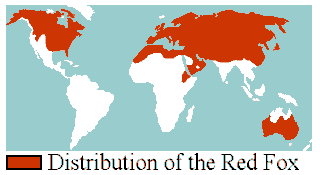 Red Fox- Vulpes vulpes
Red Fox- Vulpes vulpesThe red fox has one of the largest ranges of any land animal. It exists in almost all of North America north of Mexico with the exception of Greenland, the arctic archipelago (it was introduced on Baffin Island in 1919), parts of the west coast, and some various isolated islands. It is common throughout all of Europe and parts of north Africa. The red fox can also be found in most of Asia with the exception of Southeast Asia, southern India, and the desert regions of the Middle East. In addition, it has also been introduced to several Pacific Islands, and to the continent of Australia in 1845. The chief reason for this extremely wide range is the fox´s remarkable adaptability, principally in its ability to exploit various food sources and live in various habitats. Other widespread species, such as humans and rats, show similar flexibility.
The red fox inhabits a wide range of environments. They are known to live in coniferous and deciduous forest, marshes, desert shrub land, on prairies, and arctic tundra, not to mention their familiarity in suburban and urban environments. These animals are not common in extremely dense forest, rather preferring the boundary areas between woods and open fields. Farmland near wooded areas provides excellent fox habitat, as do urban parks and golf courses. Since human settlement in North America has greatly increased the amount of such space over the last two hundred years, the number of red foxes on that continent has increased as well.
| Table of Contents |